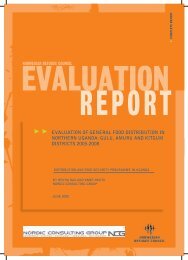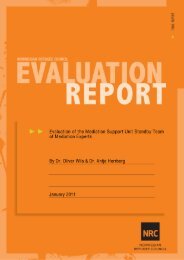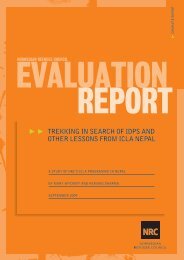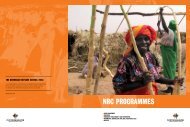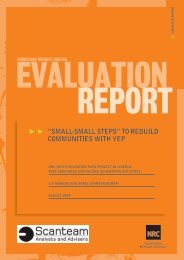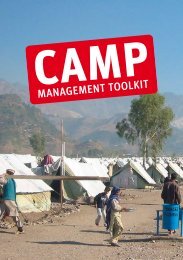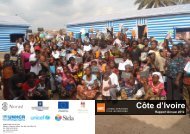Download full report - English version - ProAct Network
Download full report - English version - ProAct Network
Download full report - English version - ProAct Network
Create successful ePaper yourself
Turn your PDF publications into a flip-book with our unique Google optimized e-Paper software.
In relation to the third component of this review, several opportunities were identified where<br />
progress could be made. One of the underlying problems regarding the provision of firewood<br />
to camps as is the current practice is that there are no baseline data on a) the amount of<br />
firewood needed at a household level and b) the amount of wood actually consumed. What is<br />
apparent by the scale and extent of charcoal making in at least two of the camps is that too<br />
much wood is being delivered to the camps.<br />
In addition, the wood supplied is neither stored nor dried, which is extremely energy<br />
inefficient. Households have no incentive to themselves split or dry wood as it is currently so<br />
freely available.<br />
Manufactured briquettes have been introduced together with a fuel-efficient stove to<br />
Gihinga camp, but people do not care to use the briquettes, though they are known to burn<br />
them on some occasions. The actual fuel-efficiency rate of the current stove needs to be<br />
checked by an independent evaluation.<br />
Firewood appears to remain the firm favourite source of cooking energy and heat for<br />
households, based on feedback during this Mission as indeed it is in much of Africa.<br />
Several alternative solutions to firewood have been considered in this <strong>report</strong>, but no one<br />
stands out at this point in time as being either economically, culturally or practically feasible<br />
in the current Burundian context. However, there are several measures that NRC can take to<br />
reduce firewood consumption in camps, which are detailed in this <strong>report</strong>.<br />
Significant reductions can almost certainly already be made in the camp context, with<br />
relatively little effort or cost. A series of baseline assessments urgently need to be carried out<br />
as a first step, otherwise any further intervention will have no reference point as to its<br />
effectiveness. This may require some external guidance and training of local staff and<br />
selected representatives from the communities to undertake the initial work and subsequent<br />
periodic assessments.<br />
At the same time, however, the Mission strongly recommends that discussions are held<br />
between NRC, UNHCR, government counterparts and local community leaders to develop<br />
sound management and harvesting plans for plantations in the vicinity of camps. This would<br />
have environmental, economic and social benefits for local host communities.<br />
Reducing the current levels of firewood to camps is a challenge and should not be<br />
approached lightly. Finding a solution that accommodates all stakeholders will take<br />
some additional time but, in the meantime, some practical actions are highlighted that<br />
would already serve as an important step towards the overall goal. These include:<br />
The use of fuel-efficient stoves, combined with the adoption of good cooking practices<br />
can result in between a 25-30 per cent reduction in firewood consumption. This is<br />
currently not happening.<br />
Regular and consistent use of kitchens and cooking shelters which can also be used to<br />
dry wood should result in firewood saving of between 5-10 per cent.<br />
The use of dry wood will result in lower rates of firewood consumption (between 10-15<br />
per cent). This is extremely limited and related to lack of awareness, combined with ready<br />
access to firewood.<br />
The combination of several approaches as outlined in the <strong>report</strong> below, together with a<br />
responsible reduction of the amount of firewood provided should bring about a<br />
significant and lasting stable reduction in energy demands. Key to achieving this,<br />
however, rests on another combination of activities, namely assessments, capacity<br />
building, awareness raising and monitoring.<br />
2




